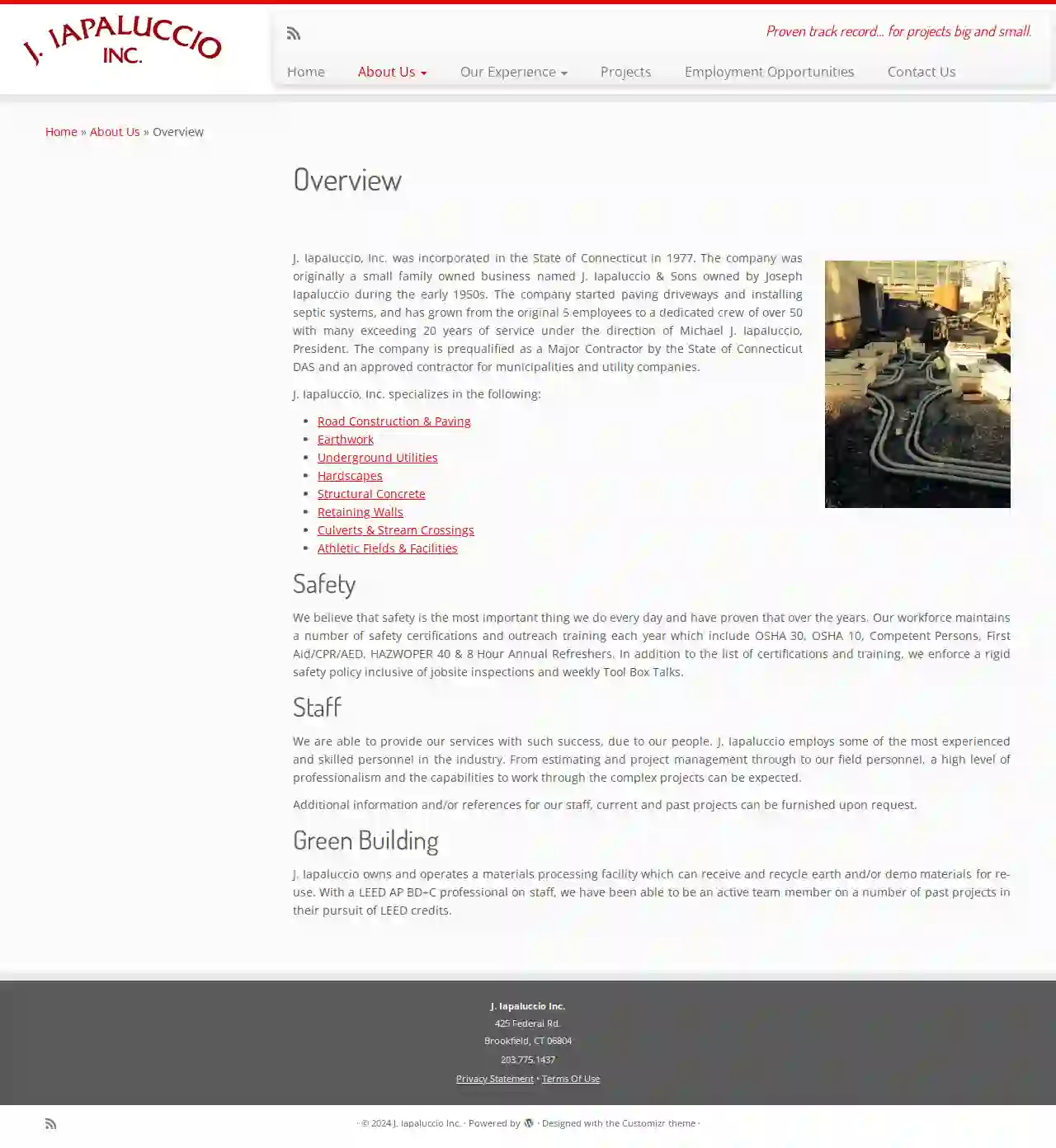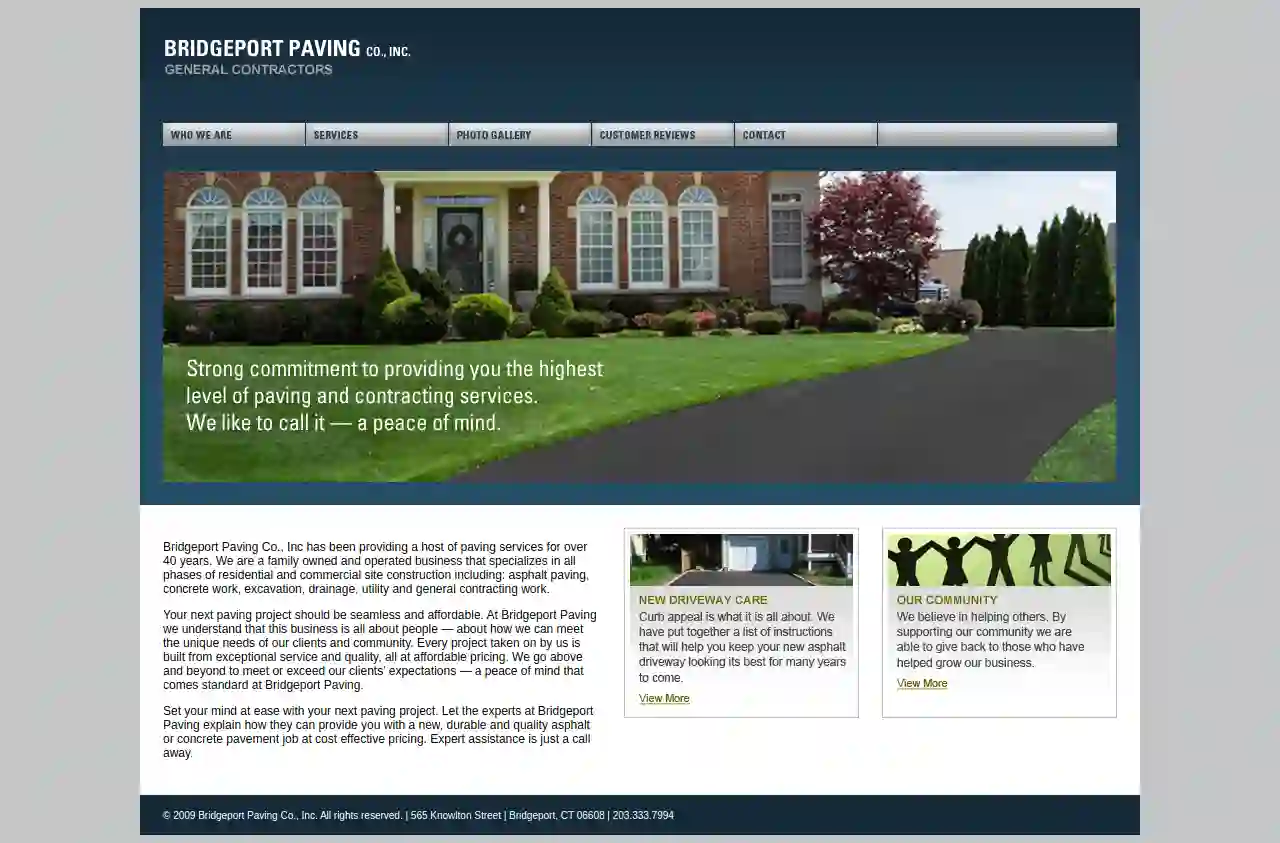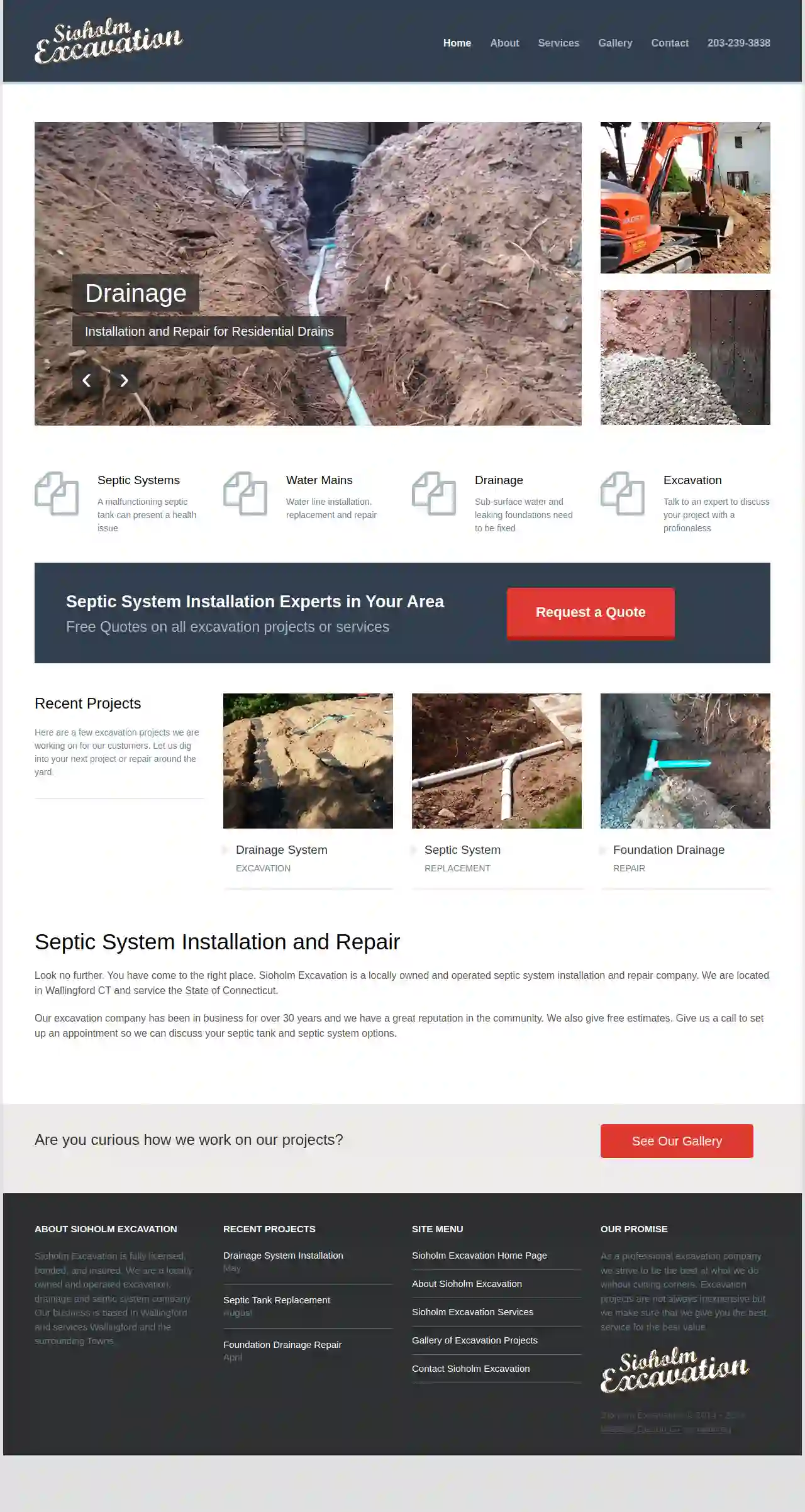Excavation Contractors Trumbull
Find top Excavation Contractor in Trumbull
Receive up to 3 Excavating Contractors quotes for your project today! Compare profiles, reviews, accreditations, portfolio, etc... and choose the best service.

Butts Bros Excavation LLC
51 reviewsNew Milford, 06776, USExcellence In Excavation When the people in our community need the expertise and professional oversight of an excavation contractor, they know to contact Butts Bros Excavation LLC. Whether you need someone to clear the land on a worksite, dig out a pond, or excavate for a home foundation, we can help you. Homeowners and skilled builders alike look to us for all their excavating needs—and the reasons why are obvious. Whether you’re most concerned with quick turnarounds, reasonable rates, or excellent results, you will surely love our approach to excavation. Book our services today for your upcoming project. Call (203) 994-5264 to schedule your consultation. Making Excavation Look Easy We are high-demand excavation contractors. Not a day goes by where we are not doing earthwork, digging trenches, or aiding the development of a new property. Over the years, we have come to understand the finer points of excavation better than the rest. We Serve the Customer We work in accordance with the standards of our trade, make no mistake. That said, we also believe in serving the customer every step of the way. We will listen to your requests, answer your questions, and address any concerns you might have. In the end, you get quality results and a customer experience like no other. Ready for Every Excavation Project Do you want to dig out a pond in the backyard of your home? Are you looking to clear a piece of property of large rocks and other masses? We can help you. Between our unparalleled expertise and vast storehouse of equipment, we can undertake just about any excavation project. Some of the services we offer include: Basement excavation Pond digging and filling Site clearing Trenches and troughs Foundation digging Grading And more Aiding Residential and Commercial Excavation Projects Since our company’s inception, we have had the opportunity to assist in projects of all varieties, from home building to commercial landscaping and everything in between. We tackle projects of all sizes—and what’s more, we treat every project with the seriousness it deserves. Would you like to learn a little more about us? Call our offices today. Your Excavation Is Always a Success with Us There are a lot of moving parts, crew members, and ongoing projects on any given worksite.
- Services
- Why Us?
- Gallery
Get Quote
High Idle Excavation
Farmingdale, USIntroducing High Idle Excavation Finding a reliable excavation contractor is crucial to the success of your project. Our experienced team at High Idle Excavation is here to make the process smooth and straightforward, turning your vision into reality with precision and efficiency. Based in Farmingdale, NY, we pride ourselves on being a locally owned and operated business, dedicated to delivering top-quality excavation services for residential and commercial clients. We offer an extensive range of services, which include expert land clearing, detailed site preparation, and precise grading and regrading. Whether you're looking to clear snow, or remove a parking lot or pool, we have the expertise and equipment to get the job done right. Our trenching and utility work ensure that your infrastructure projects are in capable hands, while our bobcat and demolition services provide the heavy-duty solutions needed for larger tasks. What sets us apart is having a comprehensive service portfolio and unwavering dedication to customer satisfaction. We offer free estimates and 24/7 emergency service calls, so no matter the time or the challenge, we're here for you. Our commitment to affordable, high-quality work means you get the best value without compromising on excellence. With a focus on friendly customer service and rapid project completion, we aim to make your excavation needs manageable and stress-free. Licensed and insured, High Idle Excavation stands ready to tackle all your excavation challenges with the professionalism and care you deserve. If you need top-notch excavation services in Farmingdale, NY, from site clearing to construction demolition, we invite you to reach out to us. Let us help turn your improvement plans into reality. Contact High Idle Excavation today to get started. Our Services Tackle your excavation project with confidence by calling High Idle Excavation at (516) 988-6600. Discover why we are the trusted excavator in Farmingdale, NY. Let's transform your property into a more usable space today! * Excavation Contractor * Excavating Services * Land Clearing * Snow Removal * Parking Lot Rip Outs * Pool Rip Outs * Trenching * Utility Work * Site Clearing * Demolition Services * Bobcat Services * Land Demolition * Grading Services * Regrading Services * Resloping Services * Site Preparation * Building Site Preparation * Construction Site Preparation * Construction Demolition * Equipment Rental * Equipment Transportation
- Services
- Why Us?
- Gallery
Get Quote
J. Iapaluccio Inc. Contractors
4.65 reviews425 Federal Rd, Brookfield, 06804, USJ. Iapaluccio, Inc. is a family-owned and operated business that has been serving the Connecticut area since the early 1950s. The company was originally founded by Joseph Iapaluccio and has grown from a small, five-person operation to a dedicated crew of over 50 employees, many of whom have been with the company for over 20 years. Michael J. Iapaluccio, President, leads the team with a commitment to quality and customer satisfaction. J. Iapaluccio, Inc. is prequalified as a Major Contractor by the State of Connecticut DAS and is an approved contractor for municipalities and utility companies. The company specializes in a wide range of civil and site construction services, including: Road Construction & Paving Earthwork Underground Utilities Hardscapes Structural Concrete Retaining Walls Culverts & Stream Crossings Athletic Fields & Facilities J. Iapaluccio, Inc. is committed to safety and has a proven track record of safety excellence. The company's workforce maintains a number of safety certifications and outreach training each year, including OSHA 30, OSHA 10, Competent Persons, First Aid/CPR/AED, HAZWOPER 40 & 8 Hour Annual Refreshers. In addition to the list of certifications and training, the company enforces a rigid safety policy inclusive of jobsite inspections and weekly Tool Box Talks. J. Iapaluccio, Inc. is also committed to sustainability and green building practices. The company owns and operates a materials processing facility which can receive and recycle earth and/or demo materials for re-use. With a LEED AP BD+C professional on staff, the company has been able to be an active team member on a number of past projects in their pursuit of LEED credits.
- Services
- Why Us?
- Gallery
Get Quote
Strollo's Excavation
516 reviews526 West Main Street, Cheshire, 06410, USStrollo's Excavation: Recreating Dream Homes That Last Strollo's Excavation began in 2003, offering a wide range of services from home additions to equipment hauling. We are dedicated to customer satisfaction and take pride in delivering exceptional results. Our team is experienced and committed to providing high-quality workmanship and sustainable solutions. Contact Bruce Strollo today for a free estimate.
- Services
- Why Us?
- Our Team
- Testimonials
- Gallery
Get Quote
W F Anderson Construction LLC
4.84 reviews4 OLD MILL PLAIN ROAD, DANBURY, 06811, USWelcome WF Anderson is a family-owned and operated business with over 30 years of experience in the landscape and excavation industry. We are committed to providing our clients with the highest quality workmanship and customer service. We offer a wide range of services to meet your needs, from small residential projects to large commercial developments. We are fully licensed and insured, and we are proud to be a member of the Better Business Bureau. History WF Anderson was founded in 1990 by William F. Anderson. Bill has over 40 years of experience in the construction industry. He is a skilled and experienced contractor who is dedicated to providing his clients with the best possible service. Bill's son, William F. Anderson Jr., joined the business in 2000. Bill Jr. has over 20 years of experience in the landscape and excavation industry. He is a licensed and insured contractor who is committed to providing his clients with the highest quality workmanship and customer service. Materials We use only the highest quality materials for all of our projects. We are committed to using environmentally friendly products whenever possible. We offer a wide variety of materials to choose from, including: - Stone - Gravel - Sand - Topsoil - Mulch Services We offer a wide range of services to meet your needs, including: - Site preparation - Excavation - Grading - Landscaping - Drainage - Retaining walls - Patios - Walkways - Driveways - And more! Gallery We are proud of our work and we want to share it with you. Please take a look at our gallery to see some of our recent projects.
- Services
- Why Us?
- Gallery
Get Quote
Bridgeport Paving Co Inc
3.52 reviews565 Knowlton Street, Bridgeport, 06608, USBridgeport Paving Co., Inc. has been providing a host of quality paving services for over 40 years. We are a family owned and operated business that specializes in all phases of residential and commercial site construction including: asphalt paving, concrete work, excavation, drainage, utility and general contracting work. Your next paving project should be seamless and affordable. At Bridgeport Paving we understand that this business is all about people — about how we can meet the unique needs of our clients and community. Every project taken on by us is built from exceptional service and quality, all at affordable pricing. We go above and beyond to meet or exceed our clients' expectations — a peace of mind that comes standard at Bridgeport Paving. Set your mind at ease with your next paving project. Let the experts at Bridgeport Paving explain how they can provide you with a new, durable and quality asphalt or concrete pavement job at cost effective pricing. Expert assistance is just a call away.
- Services
- Why Us?
- Testimonials
- Gallery
Get Quote
Sioholm Excavation
48 reviews42 New Place Street, Wallingford, 06492, USAbout Sioholm Excavation Sioholm Excavation is a locally owned and operated excavation, drainage and septic system company. We are fully licensed, bonded, and insured. Our business is based in Wallingford and services Wallingford and the surrounding Towns. Our Promise As a professional excavation company we strive to be the best at what we do without cutting corners. Excavation projects are not always inexpensive but we make sure that we give you the best service for the best value. Experience With over 3 Decades of Excavation Experience, let Sioholm Excavation help you with your installation or repairs for your home or business. Throughout the years, Sioholm Excavation has helped hundreds of customers fix their septic systems, sewer, water main, drainage and other issues as quickly as possible for a fair price. We take pride helping customers as quickly and efficiently as possible. Services Sioholm Excavation Services offers high quality installations and repairs on all types of excavation and site projects. With professional service, Sioholm Excavation is a company with years of experience who takes pride in each and every job while providing exceptional customer service. Being able to provide residential and commercial excavation services throughout Connecticut, Sioholm Excavation can work with your contractors for new construction or help you with your repairs. From septic systems to all types of property drainage, we are the number one choice for your excavation services and we will provide FREE estimates to help you figure out what your project will cost. We also can help recommend excavation solutions for certain types of problems so you can insure a complete job that works. Sioholm Excavation is committed to helping homeowners and businesses with all of their excavations needs. Professional service and quality workmanship, Sioholm Excavation is ready for your next project. Teamwork Our company is experienced in collaboratively working with all parties involved in a given project, including the homeowner, developer, general contractor, site and professional engineers, and other subcontractors. Testimonials SIoholm Excavation was there to help us get our septic system replaced right away. There is nothing worse than having no control over your water and septic system, and Bill Sioholm was there to help us get back on track. Wallingford Resident Values We pride ourselves on our honest and dependable services giving you trusted, high quality workmanship and the personal attention you deserve. Professional Dependable Courteous Experienced Knowledgeable
- Services
- Why Us?
- Testimonials
- Gallery
Get Quote
Robinson Excavation, Inc.
51 reviews39 Forest Drive, Hyde Park, 12538, USRobinson Excavation, Inc. - Your Trusted Excavation Partner in Dutchess County and Beyond For over 40 years, Robinson Excavation, Inc. has been a trusted name in Dutchess County, Hudson Valley, and surrounding areas. We are a family-owned and operated business dedicated to providing high-quality excavation and site work services for both residential and commercial clients. Our commitment to excellence, combined with our extensive experience, ensures that every project is completed to the highest standards. We understand that excavation projects can be complex and require a skilled and experienced team. That's why we have assembled a team of dedicated professionals who are passionate about delivering exceptional results. From initial planning to final completion, we work closely with our clients to ensure their vision is realized. We are fully insured and equipped to handle all phases of excavation and site work, no matter how big or small the project. Our services include: - Fix muddy driveways - Fix and replace failing septic systems - Place new septic systems - Municipal water and sewer lines (Town or City) - Footing drains - Dry wells - New foundations - Demolition - Blasting - Trucking - Paving - Delivery of shale, Item 4, all size stone, fill, and topsoil - Complete dump truck service - And much more… We are committed to providing our clients with the highest level of service and satisfaction. We believe in open communication, transparency, and working closely with our clients to ensure their needs are met. Contact us today for a free quote and let us help you bring your project to life.
- Services
- Why Us?
- Gallery
Get Quote
Jo Tree Service & Excavation LLC
52 reviews123 Main Street, Danbury, 06810, USAbout Tree Service of Danbury Tree Service of Danbury is a locally owned and operated company dedicated to providing exceptional tree care services to the residents of Danbury and surrounding areas. We are a team of highly skilled and experienced arborists who are passionate about preserving the health and beauty of your trees. We understand that trees are an important part of your property, providing shade, beauty, and value. That's why we are committed to providing the highest quality tree care services, using the latest techniques and equipment to ensure the safety and well-being of your trees. From tree trimming and pruning to tree removal and stump grinding, we offer a wide range of services to meet your needs. We also provide expert advice on tree health and maintenance, helping you keep your trees healthy and thriving for years to come. At Tree Service of Danbury, we are committed to providing our customers with exceptional service and value. We are fully insured and licensed, and we offer free estimates on all our services. Contact us today to schedule a consultation and learn more about how we can help you with your tree care needs.
- Services
- Why Us?
- Testimonials
Get Quote
Sanchez's Construction & Excavation
51 reviewsSanchez's Construction & Excavation, Danbury, 06810, USWelcome To Sanchez's Construction & Excavation A Professional Construction Contractor Construction involves a complex process, from planning and design to execution and completion. A remarkable construction service provider like Sanchez's Construction & Excavation streamlines this journey, ensuring efficiency and quality at every step. With our mastery and dedication, we handle all aspects of your project, making the construction process smoother and more manageable. From managing timelines and budgets to coordinating subcontractors and ensuring compliance, we take care of it all. Trust us to address every detail of your construction project, providing peace of mind and exceptional results. If you are in Danbury, CT, choose our construction experts for a seamless experience tailored to your needs.
- Services
- Why Us?
- Testimonials
- Gallery
Get Quote
Over 22,076+ Excavation Contractors on our platform
Our excavation experts operate in Trumbull & beyond!
ExcavationHQ has curated and vetted Top Excavation Businesses in and around Trumbull. Find a top & reliable contractor today.
Frequently Asked Questions About Excavation Contractors
- Spring and Fall: Often considered favorable due to moderate temperatures and drier soil conditions.
- Summer: Can be suitable, but hot weather can make working conditions challenging and might require additional measures (shade, hydration) for workers.
- Winter: Excavation in winter can be more difficult due to frozen ground, snow, and potential delays caused by inclement weather. It might also require specialized equipment or techniques.
- Clear the Area: Remove any obstacles, including vehicles, outdoor furniture, landscaping features, or structures, from the excavation zone and surrounding area.
- Mark Existing Features: Identify and mark underground utilities, septic tanks, sprinkler systems, or other buried elements you want to protect.
- Protect Landscaping: Use tarps or fencing to shield trees, shrubs, gardens, or other landscaping elements from damage.
- Provide Access: Ensure the excavation contractor has clear access to the work area, including gates wide enough for equipment.
- Discuss Logistics: Coordinate with the contractor regarding parking arrangements, material delivery, and any special instructions or concerns you might have.
- Excavations Deeper Than a Certain Depth: This varies by jurisdiction, usually around 5 feet.
- Excavations Near Utilities: Digging near buried utilities (gas, water, electric) often requires permits and utility locates to prevent damage.
- Excavations Affecting Public Property: Projects impacting sidewalks, roads, or other public areas typically require permits.
- Excavations in Environmentally Sensitive Areas: Projects in wetlands, floodplains, or other sensitive areas might need special permits.
- Soil Type and Stability: Stable, cohesive soils allow for deeper excavations than loose or unstable soils.
- Groundwater Level: Excavations below the water table require dewatering techniques to manage water intrusion.
- Equipment and Resources: The size and capabilities of excavation equipment influence the achievable depth.
- Safety Regulations: OSHA and other safety regulations impose limitations on trench depths without proper shoring or sloping.
- Project Requirements: The purpose of the excavation (basement, pool, foundation) determines the necessary depth.
What is the best time of year for excavation?
How do I prepare my property for excavation?
Do I need a permit for excavation?
How deep can you excavate?
What is the best time of year for excavation?
- Spring and Fall: Often considered favorable due to moderate temperatures and drier soil conditions.
- Summer: Can be suitable, but hot weather can make working conditions challenging and might require additional measures (shade, hydration) for workers.
- Winter: Excavation in winter can be more difficult due to frozen ground, snow, and potential delays caused by inclement weather. It might also require specialized equipment or techniques.
How do I prepare my property for excavation?
- Clear the Area: Remove any obstacles, including vehicles, outdoor furniture, landscaping features, or structures, from the excavation zone and surrounding area.
- Mark Existing Features: Identify and mark underground utilities, septic tanks, sprinkler systems, or other buried elements you want to protect.
- Protect Landscaping: Use tarps or fencing to shield trees, shrubs, gardens, or other landscaping elements from damage.
- Provide Access: Ensure the excavation contractor has clear access to the work area, including gates wide enough for equipment.
- Discuss Logistics: Coordinate with the contractor regarding parking arrangements, material delivery, and any special instructions or concerns you might have.
Do I need a permit for excavation?
- Excavations Deeper Than a Certain Depth: This varies by jurisdiction, usually around 5 feet.
- Excavations Near Utilities: Digging near buried utilities (gas, water, electric) often requires permits and utility locates to prevent damage.
- Excavations Affecting Public Property: Projects impacting sidewalks, roads, or other public areas typically require permits.
- Excavations in Environmentally Sensitive Areas: Projects in wetlands, floodplains, or other sensitive areas might need special permits.
How deep can you excavate?
- Soil Type and Stability: Stable, cohesive soils allow for deeper excavations than loose or unstable soils.
- Groundwater Level: Excavations below the water table require dewatering techniques to manage water intrusion.
- Equipment and Resources: The size and capabilities of excavation equipment influence the achievable depth.
- Safety Regulations: OSHA and other safety regulations impose limitations on trench depths without proper shoring or sloping.
- Project Requirements: The purpose of the excavation (basement, pool, foundation) determines the necessary depth.